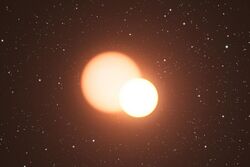Astronomy:OGLE-LMC-CEP0227
| Observation data Equinox J2000.0]] (ICRS) | |
|---|---|
| Constellation | Mensa |
| Right ascension | 04h 52m 15.678s[1] |
| Declination | −70° 14′ 31.33″[1] |
| Apparent magnitude (V) | 15.317[2] |
| Characteristics | |
| Spectral type | F7Ib + G4II[3][lower-alpha 1] |
| Apparent magnitude (J) | 13.727[1] |
| Apparent magnitude (H) | 13.217[1] |
| Apparent magnitude (K) | 13.262[1] |
| Variable type | Eclipsing binary, δ Cep[4] |
| Astrometry | |
| Distance | 163,000[5] ly (50,000 pc) |
| Orbit[3] | |
| Period (P) | 309.404±0.002 days |
| Semi-major axis (a) | 389.86±0.77 |
| Eccentricity (e) | 0.1659±0.0006 |
| Inclination (i) | 86.833±0.016° |
| Argument of periastron (ω) (secondary) | 342.0±0.6° |
| Details[3][lower-alpha 1] | |
| A (Cepheid) | |
| Mass | 4.165±0.032 M☉ |
| Radius | 34.92±0.34 R☉ |
| Luminosity | 1,439 L☉ |
| Surface gravity (log g) | 1.971±0.011 cgs |
| Temperature | 6,050±160 K |
| B | |
| Mass | 4.134±0.037 M☉ |
| Radius | 44.85±0.29 R☉ |
| Surface gravity (log g) | 1.751±0.010 cgs |
| Temperature | 5,120±130 K |
| Rotational velocity (v sin i) | 11.1±1.2 km/s |
| Other designations | |
2MASS J04521567-7014313 | |
| Database references | |
| SIMBAD | data |
OGLE-LMC-CEP0227 is an eclipsing binary and Cepheid variable star,[6] pulsating every 3.8 days.[4] The star, in the Large Magellanic Cloud, was the first Cepheid star system found to be orbiting exactly edge on.[4]

The OGLE-LMC-CEP0227 system contains two stars which orbit each other almost exactly 'edge on' to the line of sight from the Earth. This unique configuration has allowed astronomers to refine their understanding of classical Cepheid variable stars. Studies of this system have allowed astronomers to measure the Cepheid mass with unprecedented accuracy. There is still disagreement over whether the pulsational properties accurately match the mass derived from the observed orbit.[4][6]
The two stars orbit each other every 309 days, and each has a mass close to 4.1 M☉. The primary component has an effective temperature of 6,050 K and the secondary a temperature of 5,120 K.[3]
Notes
References
- ↑ 1.0 1.1 1.2 1.3 1.4 Cutri, Roc M.; Skrutskie, Michael F.; Van Dyk, Schuyler D.; Beichman, Charles A.; Carpenter, John M.; Chester, Thomas; Cambresy, Laurent; Evans, Tracey E. et al. (2003). "VizieR Online Data Catalog: 2MASS All-Sky Catalog of Point Sources (Cutri+ 2003)". CDS/ADC Collection of Electronic Catalogues 2246: II/246. Bibcode: 2003yCat.2246....0C. http://vizier.u-strasbg.fr/viz-bin/VizieR?-source=II/246.
- ↑ Soszynski, I.; Poleski, R.; Udalski, A.; Szymanski, M. K.; Kubiak, M.; Pietrzynski, G.; Wyrzykowski, L.; Szewczyk, O. et al. (2008). "The Optical Gravitational Lensing Experiment. The OGLE-III Catalog of Variable Stars. I. Classical Cepheids in the Large Magellanic Cloud". Acta Astronomica 58: 163. Bibcode: 2008AcA....58..163S.
- ↑ 3.0 3.1 3.2 3.3 Pilecki, B. (2013). "Physical parameters and the projection factor of the classical Cepheid in the binary system OGLE-LMC-CEP-0227". Monthly Notices of the Royal Astronomical Society 436 (2): 953–967. doi:10.1093/mnras/stt1529. Bibcode: 2013MNRAS.436..953P.
- ↑ 4.0 4.1 4.2 4.3 4.4 Pietrzyński, G.; Thompson, I. B.; Gieren, W.; Graczyk, D.; Bono, G.; Udalski, A.; Soszyński, I.; Minniti, D. et al. (2010). "The dynamical mass of a classical Cepheid variable star in an eclipsing binary system". Nature 468 (7323): 542–4. doi:10.1038/nature09598. PMID 21107425. Bibcode: 2010Natur.468..542P.
- ↑ Pietrzyński, G et al. (7 March 2013). "An eclipsing-binary distance to the Large Magellanic Cloud accurate to two per cent". Nature 495 (7439): 76–79. doi:10.1038/nature11878. PMID 23467166. Bibcode: 2013Natur.495...76P.
- ↑ 6.0 6.1 Neilson, H. R.; Langer, N. (2012). "Is there a mass discrepancy in the Cepheid binary OGLE-LMC-CEP0227?". Astronomy & Astrophysics 537: A26. doi:10.1051/0004-6361/201117829. Bibcode: 2012A&A...537A..26N.
\
 |


